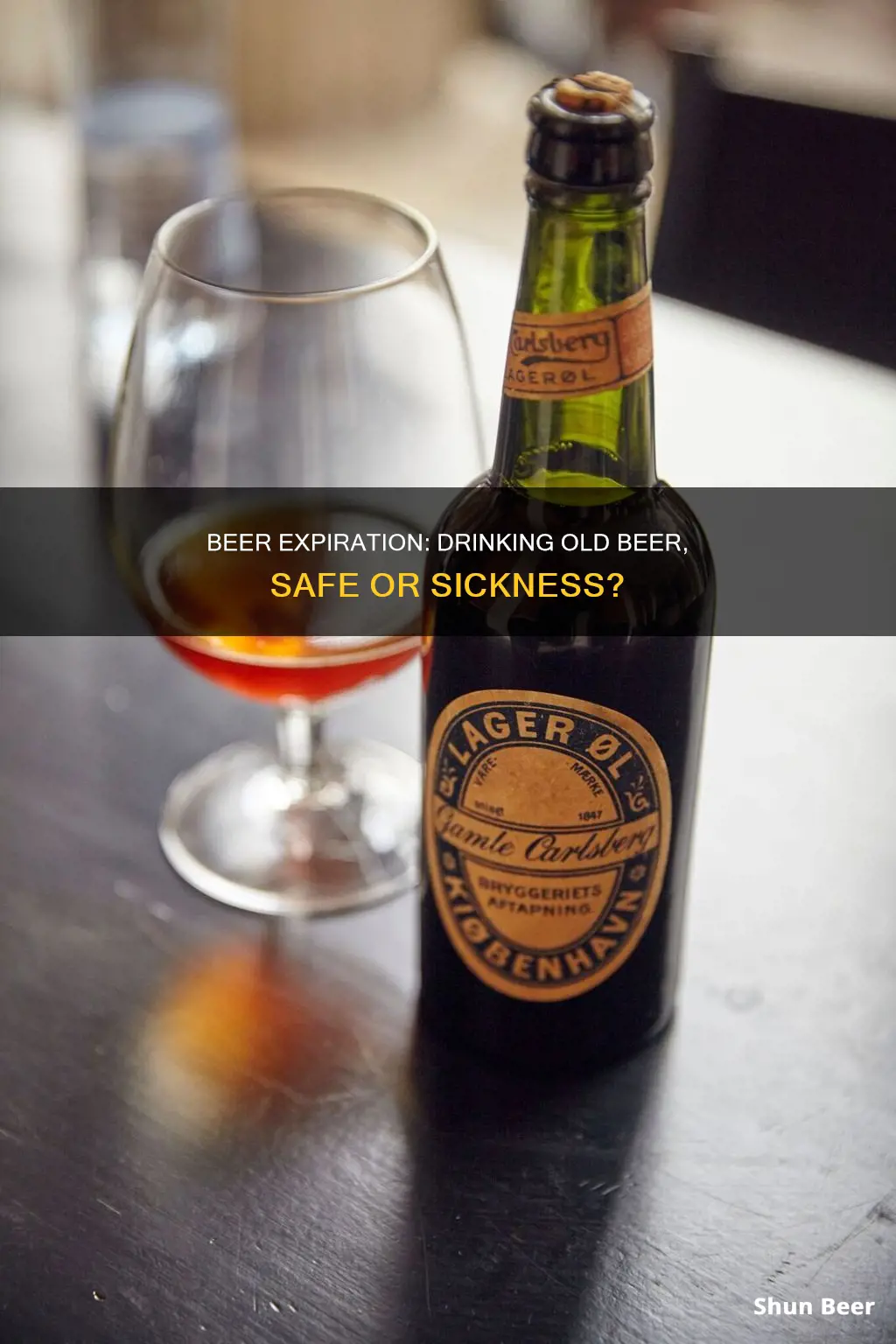
Drinking old beer will not make you sick, but it might not taste very nice. Beer is a perishable product that stales when exposed to light, oxygen, and heat, which degrade the organic compounds that make beer smell and taste great. However, the fermentation process used in brewing beer, as well as its low pH level and alcohol content, make it very resistant to bacteria. So, even if your beer is past its best before date, it should be safe to drink, but it might not taste very nice.
| Characteristics | Values |
|---|---|
| Can drinking old beer make you sick? | No, drinking old beer will not make you sick. |
| Reason | Beer is resistant to spoiling as it is pasteurized or filtered to eliminate bacteria. |
| Factors that cause beer to go bad | Light, oxygen, and heat |
| Factors that increase the shelf life of beer | Refrigeration, higher ABV, and storing in a cool, dark place |
What You'll Learn

Beer doesn't expire in the same way milk does
However, beer does have a shelf life and will eventually go bad. The taste of old beer will change, and it may lose its fizz or develop a vinegary taste, indicating bacterial growth. But even if you drink an old or expired beer, the worst thing that will happen is a bad taste in your mouth.
The main culprits that cause beer to spoil are light, oxygen, heat, and time. Hops are sensitive to UV radiation, so beer should be stored in a cool, dark place, preferably the refrigerator. Oxygen causes oxidation, which can give beer a papery or cardboard-like taste. Heat speeds up oxidation, so it's important to store beer in a refrigerator and avoid major temperature changes.
Different types of beer have different shelf lives. High-alcohol, malt-forward styles, such as barley wines and imperial stouts, are sometimes brewed with aging in mind and can be aged for a couple of years. On the other hand, hop-heavy styles like IPAs are best enjoyed fresh, as the volatile hop aromas dissipate over time.
Beer and Tea: A Safe Mix?
You may want to see also

Beer is resistant to spoiling due to pasteurisation and filtration
Beer is a drink that is resistant to spoilage. This is due to a few factors, including the fermentation process, its low pH level, and its alcohol content, which all create an unfriendly environment for microorganisms. Pasteurisation and filtration are two additional processes that can be used to further increase the shelf life of beer and prevent spoilage.
Pasteurisation is a process of heat treatment that has been used for hundreds of years to prevent food spoilage. The French scientist Louis Pasteur perfected the technique, and in 1873 he was granted a US patent for "Improvement in Brewing Beer and Ale Pasteurization". Pasteurisation involves heating beer to a temperature between 55°C and 60°C (131°F and 140°F) for a short time, which kills any living microbes and inhibits the growth of potential beer-spoiling microorganisms. This process is used in the production of most draught, bottled, and canned beers and can prolong the shelf life of beer by several months.
There are two main methods of pasteurisation: tunnel pasteurisation and flash pasteurisation. Tunnel pasteurisation is used for bottled and canned beers, where the containers are passed through a narrow chamber and sprayed with hot water for a fixed time before cooling. Flash pasteurisation, or "high-temperature/short-time" processing, is used for large containers of beer such as kegs. The beer is passed through a heat exchanger, where it is heated to 70°C-72°C (158°F-162°F) for as little as 30 seconds, and then rapidly cooled.
While pasteurisation is effective in preventing spoilage, it can also impact the flavour of the beer by accelerating the "staling" or "aging" process. This is due to the heat treatment increasing the rate of chemical changes in the beer, particularly in the presence of oxygen. As a result, some brewers may opt for a process called sterile filtration, which uses microfiltration to exclude beer-spoiling microorganisms. However, this method can also remove flavour, aroma, body, and colour from the beer.
Filtration is another process that can be used to increase the shelf life of beer and prevent spoilage. Filtration involves removing spoilage microorganisms from the beer before packaging. This technique is reliable for eliminating contaminating microbes and ensuring a good shelf life. Compounds such as Nisin can also be used to inhibit the growth of spoilage microorganisms, retaining the beer's essential characteristics and reducing brewing costs.
Beer and Cutting: Friends or Foes?
You may want to see also

Heat, light and oxygen can negatively impact the taste of beer
Heat, light, and oxygen can all negatively impact the taste of beer.
Heat
Heat accelerates the staling process of beer, producing off-flavours. The higher the temperature of the beer and the longer the exposure time, the worse the taste will be. For example, a beer that stays fresh for a year at 0°C will only last for about two weeks at 45°C.
Light
Exposure to light causes beer to become "skunky".
Oxygen
Oxygen exposure can occur anywhere in the brewing process, from the brewhouse to the fermentation cellar, and even during storage. Oxidation results in stale-tasting beer with off-putting notes that can be described as leathery, papery, or like wet cardboard. The rate of oxidation significantly increases with higher storage temperatures. For instance, a beer that stays fresh for four months at 6°C will last less than three months at 30°C.
Kids and Non-Alcoholic Beer: Is It Safe?
You may want to see also

Beer should be stored in a cool, dark place
Beer is best stored in a cool, dark place. This is because several factors can cause beer to spoil and/or lose its freshness: light, oxygen, heat, and time.
Light is a major factor in beer spoilage. Hops, a key ingredient in beer, are sensitive to UV radiation. When exposed to sunlight, beer undergoes a chemical reaction that produces 3-methyl crotyl mercaptan, a compound that gives off a distinct skunky flavour. This is why beer bottles are typically tinted brown and why canned beer has become increasingly popular—both packaging options effectively block out UV rays.
Oxygen is another factor that can cause beer to spoil. Even with modern canning and bottling techniques, a small amount of oxygen remains in each vessel of beer. Over time, this oxygen interacts with the compounds from malt, yeast, and hops, causing oxidation and an unpleasant papery taste.
Heat speeds up the oxidation process, so it's important to store beer in a cool place, preferably a refrigerator. Major changes in temperature, such as going from an ice-cold cooler to a hot car, can also negatively affect the flavour of beer.
By storing beer in a cool, dark place, you can help prevent spoilage and preserve its freshness and flavour.
Ginger Beer and Dogs: Is It Safe to Share?
You may want to see also

Beer should be enjoyed within three to six months of packaging
Beer is a perishable product that can be enjoyed well after its "best by" date. However, to enjoy beer at its finest, it is recommended to consume it within three to six months of packaging. This is because beer is susceptible to spoilage by light, oxygen, and heat, which can negatively impact its flavour and quality.
Light, specifically UV radiation, can cause a chemical reaction in hops, resulting in an unpleasant skunky flavour. This is why most beer bottles are tinted brown, and why canned beer has become increasingly popular, as it offers better protection from light. Oxygen can also cause oxidation, leading to a cardboard-like aftertaste. While a small amount of oxygen is present in any vessel of beer, refrigeration helps to slow down the oxidation process, making it important to store beer in a cool, dark place.
Heat is another factor that can accelerate the spoilage of beer. Major temperature changes, such as leaving beer in a hot car or in direct sunlight, can significantly impact its flavour. Once beer has been exposed to high temperatures, the damage cannot be reversed. Therefore, it is crucial to store beer in a refrigerator or a cool cellar to maintain its freshness.
While old beer typically does not pose any health risks, its flavour can deteriorate over time. The organic compounds that give beer its distinctive aroma and taste can dissipate, resulting in a flatter, sweeter beer. Additionally, the speed of these chemical reactions depends on the alcohol content of the beer. Beers with higher alcohol by volume tend to have a longer shelf life.
To summarise, while beer can be safely consumed past its "best by" date, it is recommended to enjoy it within three to six months of packaging to ensure optimal flavour and quality. Proper storage, such as keeping beer in a cool, dark place, can also help prolong its freshness.
Booster Shot and Beer: What's Safe?
You may want to see also
Frequently asked questions
No, drinking old beer will not make you sick. Beer is a perishable product that stales when exposed to light, oxygen, and heat, but it is extremely resistant to spoiling. The fermentation process used in brewing, as well as its low pH level and alcohol content, make beer an unfriendly environment for microorganisms.
If your beer has lost its fizz, or if it has a vinegary taste, it is too old.
Keep your beer in a cool, dark place, preferably a refrigerator. If you're storing at room temperature, make sure it's not exposed to sunlight. Leave your beers standing upright to minimise their exposure to oxygen.







